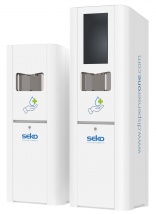Home › magazine › product features › Achieving large scale hand sanitizing for a COVID secure future
Achieving large-scale hand sanitizing for a COVID-secure future
10th of August 2020A SEKO white paper exploring the limitations of traditional light-duty hand sanitizer dispensers in buildings and the need for high-capacity systems to meet unprecedented global demand post-coronavirus.
The pre-coronavirus world
Before the COVID-19 pandemic occurred, there was little importance placed on hand sanitizing outside of hospitals, surgeries and other healthcare centres.
The dispensers available at that time were adequate, could comfortably meet demand and, due to their limited usage, did not require excessive maintenance.
In 2018, the European hand sanitizer market was valued at $641.7 million*.
Today
Post-coronavirus, the world has changed irrevocably, with heightened awareness of personal hygiene and virus prevention meaning that regular hand disinfection is now a normal part of our daily habits.
The result is an unprecedented growth in the need for hand sanitizer dispensers, with the European market expected to reach $9.4 billion by 2027*.
The majority of suppliers have responded to the surge in demand by installing traditional 1-litre light-duty units, compatible with gel sanitizer supplied in disposable cartridges or pouches.
The changes since COVID-19 took hold can be seen everywhere, with dispensers now a common sight in locations as varied as supermarkets, car dealerships, leisure attractions, offices and transport hubs.
The problem
Despite the efforts of building maintenance managers to make their sites COVID-secure, the installation of light-duty sanitizer dispensers has not provided an adequate solution. This is due to a number of limitations that mean they are unsuitable for the huge demand we are seeing post-coronavirus.
Low capacity
A conventional 1-litre dispenser provides just 1,000 doses of sanitizer on average, meaning that in sites with medium to high foot traffic, cleaning staff can't possibly manage the constant replenishment required.
For example, Beijing Capital International Airport handled an average of 205,000 passengers per day pre-coronavirus**, and to provide sanitizer on demand for such numbers would require hundreds of dispensers and dedicated service operatives to check and refill dispensers round the clock.
The reality is that dispensers regularly run dry, leaving users unprotected and eroding confidence in the building management's determination to provide a safe, COVID-secure environment. This can lead to visitors forming a negative perception of the company itself and a reluctance to use the facility in the future.
Reliance on batteries
In order to power touch-free dosing, standard-sized automatic dispensers rely on batteries which must be changed regularly, with maintenance personnel unaware that batteries are low until they run out and render the unit inactive. Therefore, in large office buildings, supermarkets and conference centres, managing battery replacement effectively is unrealistic.
Along with the ongoing cost of batteries, such systems leave operators vulnerable to multiple out-of-service dispensers across the site, leaving visitors without access to sanitizer which reflects poorly on the building and brand.
Environmentally unfriendly
For decades, the practice of fitting dispensers to receive disposable sanitizer cartridges and pouches, as well as single-use batteries, has been commonplace. However, with the world committed to reducing CO2 emissions, the impact of using such consumables is unacceptable to managers already under pressure to demonstrate their commitment to minimizing the environmental effect of their operations.
Unhygienic
Conventional non-electric dispensers that require users to manually pump sanitizer via a push button carry a significant hygiene risk, as the surface of the unit may harbour and transfer viruses to subsequent users.
Considering this in a sports stadium, for example, where tens of thousands of spectators may use dispensers within a few hours, the contamination risk - should just one infected visitor pass through - is vast.
High maintenance requirement
In busy locations such as theme parks, dispensers are vulnerable to improper use such as excessive force from impatient visitors, which can cause the spring-loaded pump to prematurely degrade and fail. Along with an increased maintenance requirement, this can result in sanitizer leakage which not only wastes product but leads to unsightly mess, reducing user satisfaction.
Excessive chemical consumption
Despite manual dispensers delivering a pre-set quantity of sanitizer, such systems are prone to chemical wastage as users may press the dispensing button multiple times in order to receive more product. Across a large site, excessive sanitizer consumption adds up to a significant added cost, while this limitation exacerbates the low capacity problem faced by conventional systems.
Product limitation
Some standard dispensers are fitted with a fixed pump device which restricts use to a single form of sanitizer; commonly gel, liquid or foam. Should the regular sanitizer supply suddenly become unavailable, using an alternative product is then not an option and dispensers are left out of operation.
User safety
Today we see an increasing focus on making buildings inclusive environments, welcoming visitors with facilities suitable for all, including disabled people and children, yet many wall-mounted and portable dispensers are not designed with every user in mind.
For example, it's common to see standard sanitizer dispensers set at a height that make access by children and wheelchair users difficult and also exposes them to potential eye injury from ‘splashing' caused by liquid-dispensing systems, particularly in the case of manual dispensers where the push-button mechanism means dosing force is uncontrolled.
The solution
In order for the commercial, leisure and transport industries to return to normality and ensure coronavirus is controlled and ultimately defeated, a groundbreaking solution is required.
SEKO, a cleaning and hygiene systems manufacturer with 45 years' experience in the sector, has responded by developing DispenserONE®, a high-capacity hand sanitizer system that solves these issues while offering an enhanced user and operator experience.
Revolutionary dosing technology
DispenserONE®'s dosing mechanism, unprecedented in sanitizer dispensing, automatically provides a precise, consistent quantity of product every time, with ‘soft' delivery meaning the risk of splashing is eliminated.
This advanced technology provides hundreds of thousands of doses with a minimal maintenance requirement - a level of performance that is unmatched by any other dispenser available today.
Large capacity
DispenserONE®'s high-capacity tank allows up to 25 litres of sanitizer to be connected - equating to 25,000 doses on average. This vastly reduces the replenishment rate for even the busiest sites to daily or even weekly refills, significantly easing pressure on maintenance personnel, allowing operators to allocate staff elsewhere.
In addition, by ensuring visitors always have access to sanitizer, the operator provides reassurance that their wellbeing is of paramount importance in the wake of coronavirus, projecting a responsible, COVID-secure brand image.
Mains powered
With its connection to mains electricity, DispenserONE® frees operators of their reliance on single-use batteries and the associated maintenance costs, guarantees continuous use and removes the environmental impact of battery disposal.
Touchless technology
In order to maximize hand hygiene and user safety, DispenserONE® helps operators to prevent the transmission of viruses across the site and beyond with its automatic sensor-activated delivery.
This technology also guarantees that users receive the correct quantity of sanitizer every time, ensuring proper hand sanitization while reducing the wastage associated with manually-operated units.
Remote access
The IoT-ready DispenserONE® includes a built-in Wi-Fi hotspot, allowing operators to track usage, check chemical level, view operational status and schedule maintenance from anywhere via PC, laptop or smart device.
The freedom to manage DispenserONE® from any location means building operators working from home can view data and make adjustments immediately and minimize costly unplanned downtime by identifying and correcting issues before they lead to system failure.
And by monitoring usage data on demand for multiple units across different sites, managers can facilitate control of sanitizer stock and make informed decisions on the need for additional systems as user numbers change.
Minimal maintenance
Remote maintenance features such as a low-level alarm and immediate access to settings, combined with a reduction in the time spent replenishing sanitizer and changing batteries, enable DispenserONE® operators to significantly cut running costs and allocate investment elsewhere.
Environmentally friendly
DispenserONE®'s mains power connection and bulk product capacity allow managers to avoid the negative environmental impact of disposing batteries and empty sanitizer cartridges associated with traditional sanitizer dispensers, helping management to achieve and maintain sustainable operations alongside COVID security.
Enhanced user experience
A plentiful supply of sanitizer not only helps guarantee every visitor has access to hand hygiene when they need it, it also instils confidence and reassurance that the site is COVID secure.
DispenserONE®'s 25-litre tank capacity and mains-powered operation ensures sanitizer is always on hand for a positive user experience that reflects well on the building and brand.
A safe solution for all
By locating DispenserONE®'s delivery nozzle at a height suitable for children and wheelchair users and integrating touch-free dispensing to remove manual pumping, SEKO's system has been designed with every user in mind.
Video screen
DispenserONE® has also been made available in a 17" screen version, with a high-quality display that provides the opportunity to sell advertising space for additional revenue, display promotions or show visitor information.
Operators have the choice to upload media via USB or remotely through the system's built-in Wi-Fi hotspot, meaning content can updated quickly and easily to ensure it remains current and relevant.
Flexible product choice
DispenserONE®'s compatibility with both liquid and gel sanitizer means operators are not bound to a single product, so in the event of the existing sanitizer type becoming unavailable, an alternative can be connected without interruption to service.
Customization
DispenserONE® can be customized with the company's logo and a choice of any colour, creating a product unique to its environment that can deliver brand consistency across multiple sites.
Conclusion
It's highly likely that life will never return to the normality we knew pre-coronavirus. DispenserONE® allows operators to manage what is likely to be a turbulent post-COVID-19 period when they will face the challenge of encouraging visitors, customers and other building users to return and convincing them that their environment is safe.
By addressing the limitations of conventional dispensers while adding multiple benefits for both operators and users, SEKO's DispenserONE® ensures buildings can offer effective, reliable hand hygiene for every visitor.
Looking to the future, it's almost certain that regular hand sanitization is set to become a normal part of our daily routine while using public spaces, with dispensers becoming an essential element of any site. DispenserONE, therefore, not only serves a vital purpose during the immediate post-coronavirus period, but also represents a shrewd long-term investment for every operator.
For more information visit: www.dispenserone.com
* Data from The Insight Partners (https://www.globenewswire.com/news-release/2020/04/23/2020724/0/en/The-European-hand-sanitizer-market-was-valued-at-US-641-7-million-in-2018-and-is-expected-to-reach-US-9-413-5-million-by-2027.html).
** Data from Airport Technology www.airport-technology.com.











